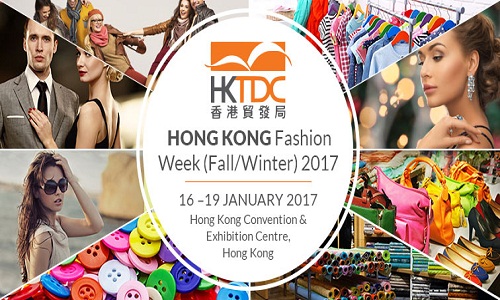FW
"More than 1,500 exhibitors from 20 countries and regions will take part in the 48th HKTDC Hong Kong Fashion Week for Fall/Winter. Organised by the Hong Kong Trade Development Council (HKTDC) it opens its doors from January 16 up to 19 at the Hong Kong Convention and Exhibition Centre."

More than 1,500 exhibitors from 20 countries and regions will take part in the 48th HKTDC Hong Kong Fashion Week for Fall/Winter. Organised by the Hong Kong Trade Development Council (HKTDC) it opens its doors from January 16 up to 19 at the Hong Kong Convention and Exhibition Centre.

Fashion collections, seminars top attractions Some 20 fashion events including a variety of fashion shows, trend forecasting seminars, forums and networking events will be staged. Under the theme ‘Hall of Games’, Fashion Week welcomes first-time exhibitors from Sweden, Italy and Pakistan with two new zones: ‘Fashionable Sportswear’ and ‘Denim & Casual Wear’. Fair highlights will include two Fashionally Collection shows staged by 14 fashion brands from emerging design talents showcasing the 2017 Fall/Winter collections, such as first-time participants Jane Ng, Yeung Chin, Kenson Tam, Winnie Chen and Key Chow.
The Buyer Forum will delve on ‘Opportunities in Emerging Markets’ where the speakers would be Cambodia’s Pohlam Seila, Principal Founder of Artisanry and Russias Ruben Nariyants, Head Logisitics Department. Fashion Snoops will host a seminar ‘Key Trends Stories for Men and Women’s Wear for S/S 2018’ where the speaker would be Michael Leow of Fashion Snoops.
The Woolmark Company will analyse trends for wool and host the ‘Seminar on The Wool Lab S/S18’. ZALORA’s Managing Director will share his insights at the seminar titled ‘ZALORA: Navigating the Wave of Omni-Channel Retailing’. During the event, Fashion Snoops will deliver seminar on ‘The Key Trend Stories for Men’s and Women’s Wear for S/S 2018’. A Buyer Forum has also been organised on the second day of the show. This will be followed by Seminar on ‘Knitting Tech – From Materials to Finishing’.
Pakistan has unveiled a package to boost the country’s exports. Duty drawback for garments would be seven per cent, for textile made-ups six per cent, for processed fabrics five per cent, for yarn and grey fabric four per cent, for sports goods, leather and footwear seven per cent and for carpets and tents five per cent.
Import duties on cotton, customs duty on manmade fiber other than polyester and sales tax on imports of textile machinery have been abolished. Liberal incentives are likely. Exporters will be liable to increase exports by five per cent from January to June 2017 and then by a further 10 per cent in financial year 2017-18.
Dozens of power plants are being installed under the China Pakistan Economic Corridor. The objective is to ensure availability of cheaper electricity on a sustainable basis. The plan is that 10,000 megawatts of electricity would be added to the system by next year and 30,000 megawatts within the next few years.
A network of roads, highways and motorways will be laid, integrating different regions of the country. Interest rates have been lowered and investors are being facilitated. The zero-rated facility has been given to five export sectors in the budget.
Developed by renowned trend experts from Tokyo, New York, Milan and Paris, the Intertextile Directions Trend Forum will present three trends for Spring / Summer 2019 under the overall theme ‘Dialogue’: @ sense, # couture and e. native. Exhibitors’ fabrics will illustrate the colour, fabric and print styles of each trend. This season witnesses an enriched palette, encapsulating a refined and premium feel. Refreshing and vivid colours introduce a sense of vitality and elicit creativity.
@ sense
@ sense is an encounter with an unknown inner sense of beauty, while exploring maximised yet imperceptible appeal buried deep within the self. Natural tenderness comes face-to-face with dignified strength, paving the way for us to nurture a sensitively cool and ultimately soothing attitude. Emphasising serene elegance in profundity and blooming anew with a placid allure.


# couture
It is the creation of a novel and chic couture; exhilarating freshness adorned with a sleek, sporty rhythm – revisiting the origin of elegance. Innocent charm joins with an energetic and playful mode for new revitalisation.


e. native
Escaping from daily life awhile, embark on a journey – exploring your own roots and awakening internal instincts. It celebrates global connectivity, borderless inspiration and multi-art cultures, awash with vibrant, inter-stimulating emotions. It also perceives enticing and sensual excitement...imbued with native-inspired human strength and vital pulsation.


Additions…
Along with all these, three Fabrics China Trend Forums will illustrate the domestic trends for ladieswear and menswear, as well as a ‘Fashion Focus’ area. A number of seminars will also be held to give more insight into the S/S 19 trends. In addition to Intertextile Shanghai Apparel Fabrics, four other textile fairs also take place at the National Exhibition and Convention Center from March 14 to 16, 2018 and these are: Yarn Expo Spring, Intertextile Shanghai Home Textiles – Spring Edition, fashion garment fair CHIC and knitting fair PH Value.
On entering Vietnam, Unifi Inc continues to spread the global footprint of REPREVE recycled fiber, with the support from Century Synthetic Fiber Corp, a licensed manufacturer of Repreve. While Century Corp will manufacture, sell and distribute Repreve filament yarn within the country, Unifi Textiles (Suzhou) (UTSC), Unifi’s subsidiary in China will manage sales and distribution of Repreve filament yarn exported from Vietnam.
This collaboration will open distribution channels for Repreve in a key apparel-producing region helping to fulfill increasing demand and shorten lead times to the company’s customer base. Headquartered in Ho Chi Minh City, Vietnam, Century Synthetic Fiber is one of the largest polyester yarn manufacturers of Vietnam. The company that was established more than 15 years ago, continues to invest in its operations and expand capacity today.
Tom Caudle, President Unifi avers that Vietnam has been a region of focus for brands and retailers over the past few years. With exports of approximately $27 billion in apparel and textiles in 2015, growth in the region and expectations to grow to $30 billion in 2016. Within the past 18 months cannot be ignored. He further said that his company has been distributing REPREVE to countries including Turkey, Taiwan, Sri Lanka and now Vietnam.
Jay Hertwig, VP of global brand sales, marketing and product development for Unifi, added this was a strategic position in growing the global supply chain for Repreve and will allow his company to expand into other Premium Value Added (PVA) products in the near future. A presence in Vietnam will enable Unifi to meet sourcing requests and increasing demand from our customers wherever they choose to do business.
The Tirupur Exporters’ Association (TEA) has forward a number of measures before the Union Textile Ministry including keeping the industry under lowest slab of GST, rebate on state levies, labour law reforms and setting up of knitwear board, among others. TEA president Raja M Shanmugham said. This, because of its MSME dominant nature and the slender margins in which the textile industry was operating, the entire textile sector may be placed in the lowest slab of the GST.
With this, the industry can absorb the levy without any significant impact on business, he said at a meeting with Textile minister Smriti Irani. In his memo to the minister, he said that there is a long pending problem whereby job workers are being denied EPCG licences for capital goods imports.
Despite repeated representations and even after the issue of clarificatory circular in September 2016, this issue has not been resolved yet. There is an urgent need to resolve the issue to reinstate a climate of investment in micro and small industries that has shelved investment plans for more than 18 months now, he added.
The benefits announced in the special package in June 2016 included rebate on state levies, EPF benefits for new employment are yet to be passed on to the exporters. Optional ESI/EPF contribution for employees below a certain threshold minimum wages as indicated in Para 61 and 62 of Budget speech of 2015 that is yet to be implemented through an amendment in PF and ESI Acts may be expeditiously given effect, he wrote in his memo.
Shanmugham stated that as a permanent solution to the problem of lack of interface between government and the industry, a focused and dedicated agency similar to Silk Board or Coir Board be formed specifically for the knitwear sector which can serve as a catalyst for rapid growth of this segment.
Pakistan has unveiled a package to boost the country’s exports. Duty drawback for garments would be seven per cent, for textile made-ups six per cent, for processed fabrics five per cent, for yarn and grey fabric four per cent, for sports goods, leather and footwear seven per cent and for carpets and tents five per cent.
Import duties on cotton, customs duty on manmade fiber other than polyester and sales tax on imports of textile machinery have been abolished. Liberal incentives are likely. Exporters will be liable to increase exports by five per cent from January to June 2017 and then by a further 10 per cent in financial year 2017-18.
Dozens of power plants are being installed under the China Pakistan Economic Corridor. The objective is to ensure availability of cheaper electricity on a sustainable basis. The plan is that 10,000 megawatts of electricity would be added to the system by next year and 30,000 megawatts within the next few years.
A network of roads, highways and motorways will be laid, integrating different regions of the country. Interest rates have been lowered and investors are being facilitated. The zero-rated facility has been given to five export sectors in the budget.
Though Pakistan seems to have placed a lot of faith in the ‘game-changing’ China-Pakistan Economic Corridor (CPEC) but local business community is concerned. Stakeholders in the country’s textile sector are anticipating a further decline fearing if Chinese companies started relocating their textile units in different tax-free industrial zones in Pakistan, they would go out of business.
In a talk, Pakistan Readymade Garments Manufacturers and Exporters Association (PRGMEA) Senior Vice President Jawad Choudhry said whenever China enters any country, it damages the domestic market. He observed that the readymade garment industry was currently facing a decline due to the high cost of doing business and productivity whereas China plays with price by increasing its production, he added.
Experts believe if China locates textile units to Pakistan, they will have an edge over existing players due to tax-free zones, under CPEC. An additional benefit for them would be the energy prices as they are setting up their own power plants to feed their industries in Pakistan.
With its intention to train unskilled workforce and help them make a good living by earning more, the Khadi and Village Industries Commission (KVIC) has sent a proposal to the Central government seeking inclusion of khadi in MNREGA, says Vinay Kumar Saxena, Chairman, KVIC.
He said the proposal was sent not only to have more artisans under the scheme but also to make unskilled workers earn more through it. These artisans will train the 5.40 lakh unskilled workers before involving them in khadi production. This in turn would help them raise their annual income from Rs 20,000 to Rs 73,000.
Besides, National President of the Textile Association (India) Arvind Sinha claimed the move will generate employment and enhance skill development amongst youth. He said the move will not only help the workers but in the long run will be very fruitful for the textile industry especially the Micro, Small and Medium Enterprises (MSMEs). It will also help enhancing technology in the related sectors, he added.
National Rural Employment Guarantee Act 2005 (or, NREGA No 42) which was later renamed as the ‘Mahatma Gandhi National Rural Employment Guarantee Act’ or MGNREGA is an Indian labour law and social security measure that aims to guarantee the 'right to work'. It aims to enhance livelihood security in rural areas by providing at least 100 days of wage employment in a financial year to every household whose adult members volunteer to do unskilled manual work.
Canadian apparel maker Gildan Activewear has bought US fashion retailer American Apparel in an auction. Gildan will not take control of any of American Apparel's 110 stores but will own the brand and assume ownership of some of American Apparel’s manufacturing plants in southern California, one of the largest garment-making operations in the United States, with about 3,500 employees.
Gildan makes most of its garments offshore, with close to 90 per cent of its 42,000 employees in low-cost Caribbean and Central American countries. It has yarn spinning and distribution centers in cheaper parts of the United States, including North Carolina and Georgia.
American Apparel filed for bankruptcy after the failure of a turnaround plan implemented by its owners, a group of former bondholders. The company's finances deteriorated and sales declined. The iconic company was founded in 1998 and grew to become a part of US popular culture thanks to its racy advertising.
American Apparel’s struggles show the major challenges facing brick-and-mortar retailers as more consumers shop online. Several US retailers, including Aeropostale and Pacific Sunwear, have filed for bankruptcy in recent months. The spending habits of young people have shifted and they visit malls less often and are increasingly going online.
Pitti Uomo is being held in Italy, January 10 to 13, 2017. This men’s fashion event has dance as its guiding theme and is presenting the Autumn/Winter collections of 1,220 brands, 44 per cent of which are non-Italian. The trade fair has become a global leader in men’s fashion thanks to its alchemy between fair and events outside it, innovation that is contagious for brands, ways of presenting collections and the ability to mix things up.
This year the number of international experimental brands represents more than 40 per cent of the 1,220 brands present and 20 per cent of the turnover. The Italian men's fashion industry closed 2016 with a slight increase in turnover. However, it is losing steam due to competition from countries outside the European Union. Purchases are declining in particular from the United States, the main end market of Italian men's fashion. In the January-September 2016 period, exports to the US fell by 10 per cent. But the Far East is showing a dynamic trend. In the first nine months of 2016, exports were up 14.6 per cent to Hong Kong, 11.3 per cent to Japan, 5.6 per cent to China and 1.8 per cent to South Korea.












